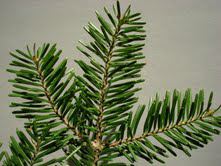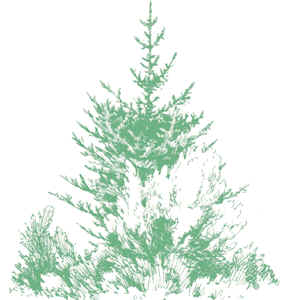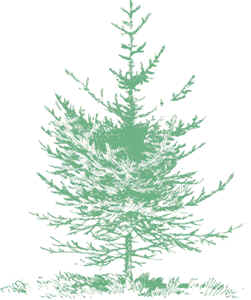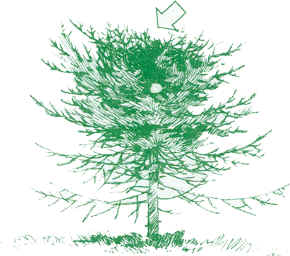Bulletin #7089, Growing a Continuous Supply of Balsam Fir Wreath Brush
Originally developed by William D. Lilley, Forestry Specialist, and Vivianne J. Holmes, Extension Educator, University of Maine Cooperative Extension. Reviewed and with new information by David Fuller, Agriculture/Non-Timber Forest Products Professional, University of Maine Cooperative Extension.
For information about UMaine Extension programs and resources, visit extension.umaine.edu.
Find more of our publications and books at extension.umaine.edu/publications/.
Table of Contents
- Stand Selection
- Soils
- Weeding
- Thinning
- Fertilizer and Lime
- Insects and Diseases
- Harvesting Tips
- VIDEO: Maine Balsam Fir Tips: A Sustainable Harvest (YouTube)

Balsam fir grows naturally over much of Maine. According to 1982 reports, there once were more than 8,000,000 acres where spruce-fir was the predominant species. These spruce-fir areas were generally located north of U.S. Route 2 and in Hancock and Washington counties. However, there are other suitable locations in Maine to grow balsam fir.
You can gather tips* from unmanaged stands for a few years without any care, but eventually the trees will grow and the tips will be out of your reach. Many fir stands are excellent areas for the production of a continuous supply of high quality tips for wreath production. With some planning and a small investment of time, these areas can be managed to supply tips each year. A crop of tips can be grown on a small area, and keep costs and gathering time as low as possible.
Stand Selection
Areas suitable for wreath brush management will have balsam fir as the predominant species. The stand should be well established, with trees 10 to 15 feet tall and growing vigorously. Access is important for the tip gatherer, but often stands by the side of a main road are tempting to non-authorized gatherers. With the increase in value of fir tips, landowners have become more concerned about “tip rustlers.”
Soils
The soil that balsam fir grows in is an important consideration in choosing an area to be managed. Soils on which balsam fir grows best are classified as well drained. They range from silt loams to stony loams. Fir will also grow, but comparatively slowly, on gravelly sands and on very wet sites. Check with your local Soil Conservation Service Office for information regarding the suitability of specific soils.
Weeding
Sunlight is the most important factor in growing good brush. Both hardwood and softwood trees, other than balsam fir, are considered weeds to the brush grower. Trees that overtop or shade even the lowest branches of the fir should be cut, the tops lopped and left to decay, unless they have some market value. Weeding is necessary in planted stands as well as in naturally seeded ones. The methods are the same in both cases.
Conifers will not sprout after they have been cut low and no green limbs are left. Hardwoods, however, will sprout vigorously when cut. These sprouts must be controlled, or they will grow up rather quickly and shade the fir. The sprouts may be cut by hand, or they may be controlled with a chemical herbicide. Cutting hardwood sprouts will likely have to be repeated. Contact the University of Maine Cooperative Extension or the Maine Forest Service for recommendations.
Thinning
Space your trees for more and better tips. After weed trees have been eliminated, some fir trees may still be too close together. Spacing the crop trees will ensure adequate sunlight to all branches and produce thicker, rounded tips. The balsam fir should be thinned to a spacing of eight to 10 feet apart (approximately 500 trees/acre). This spacing gives room for the trees to branch out and receive full sunlight on all sides. The spacing also makes it easier for tip pickers to gather the tips. When thinning, eliminate the poorer or weaker trees, such as trees that are off-color or severely damaged by insects or disease. If this thinning is done during the wreath-making season, tips from the cut trees can be used. To keep the tree short, you should prune all tops that start to turn up every other year. This will cause the tree to brush out, and concentrate its growth into branches and tips rather than height.
If you wish to use pole clippers to harvest tips, you could top trees at 10 to 12 feet. You would need to space the trees further apart. Trees in good growing locations that are thinned and topped should grow abundant tips for many years.
Fertilizer and Lime
In general, fertilization of forest trees does not enhance growth. Fertilization will enhance needle retention and may improve color. The application of two to five ounces of nitrogen fertilizer, such as urea, around the drip line of each tree in the spring of the year before the tips will be harvested may cause off-color trees to “green up.” This practice can be expensive and the results are not consistent. Thinning the stand may also do this. So before fertilizing, have a foliar analysis done to determine the precise deficiencies.
Also, a soil test for Christmas trees can help to determine if lime is needed. Foliar analysis and soil tests are available from the University of Maine Analytical Laboratory and Soil Testing Service, 207.581.3591.
Insects and Diseases
Assistance with identifying and treating insect and disease problems is available from University of Maine Cooperative Extension Pest Management Unit, 207.581.3880, or the Maine Forest Service, Insect and Disease Laboratory, 207.287.2431.
Harvesting Tips
Balsam fir can have many different appearances, depending on where the tree is growing and from what part you collect tips. Begin by looking for healthy trees with good green color. In managed areas, the trees produce sturdy, well-developed branches because there is adequate sunlight. Check for “rounded” needle arrangement (often referred to as bottle-brush). Avoid lower branches, which usually have a “flat” needle arrangement and may lack good color and vigor. Also avoid the top of the tree, as it often produces “curly,” “spiky” or “crispy” branches, which are unacceptable for wreath making because they are often unruly, dry out quickly and cause early shedding of needles. The best tips can be collected from the mid-section of the sunny side of the tree.
Always leave at least two-thirds of the live limbs on the tree because a balsam fir produces its food for growth in its needles. Enough foliage must be left each year to keep the tree healthy. In addition, a good strategy is to harvest tips from one-third of the managed trees each year. This will save you time while harvesting, and create a three-year cycle that will allow the trees to recover before the next crop is picked.
Gather tips only after cold weather has hardened (set) the needles. In Maine, this is usually in early November, but the starting date varies by region (i.e., earlier in northern sections). Cold weather is needed to set the growth and prevent needle shedding before the holidays. Although the last week in October may be a safe harvesting date in colder parts of Maine, November harvesting is more dependable in warmer sections.
A safe harvesting date can be estimated from temperature records. As a general rule, tips can be harvested after an accumulation of 20 days, beginning in September, in which the temperature has dropped below 40 degrees F or after a minimum of three consecutive 20 degrees F or colder nights have occurred after November 1.





* Throughout this publication the terms “tip” and “brush” are both used. “Tips” is a specific term and refers to the end portion of a balsam fir branch. “Tips” range from 12 to 20 inches in length. Two to four tip bunches are placed together and wired onto a ring to form a wreath. “Brush” is a general term referring to balsam fir branches. Here are some management suggestions to help you grow balsam fir wreath tips as a regular fall crop.
Illustrations by Mark A. McCollough.
Information in this publication is provided purely for educational purposes. No responsibility is assumed for any problems associated with the use of products or services mentioned. No endorsement of products or companies is intended, nor is criticism of unnamed products or companies implied.
© 1991, 2008, 2015
Call 800.287.0274 (in Maine), or 207.581.3188, for information on publications and program offerings from University of Maine Cooperative Extension, or visit extension.umaine.edu.
In complying with the letter and spirit of applicable laws and pursuing its own goals of diversity, the University of Maine System does not discriminate on the grounds of race, color, religion, sex, sexual orientation, transgender status, gender, gender identity or expression, ethnicity, national origin, citizenship status, familial status, ancestry, age, disability physical or mental, genetic information, or veterans or military status in employment, education, and all other programs and activities. The University provides reasonable accommodations to qualified individuals with disabilities upon request. The following person has been designated to handle inquiries regarding non-discrimination policies: Director of Equal Opportunity and Title IX Services, 5713 Chadbourne Hall, Room 412, University of Maine, Orono, ME 04469-5713, 207.581.1226, TTY 711 (Maine Relay System).

